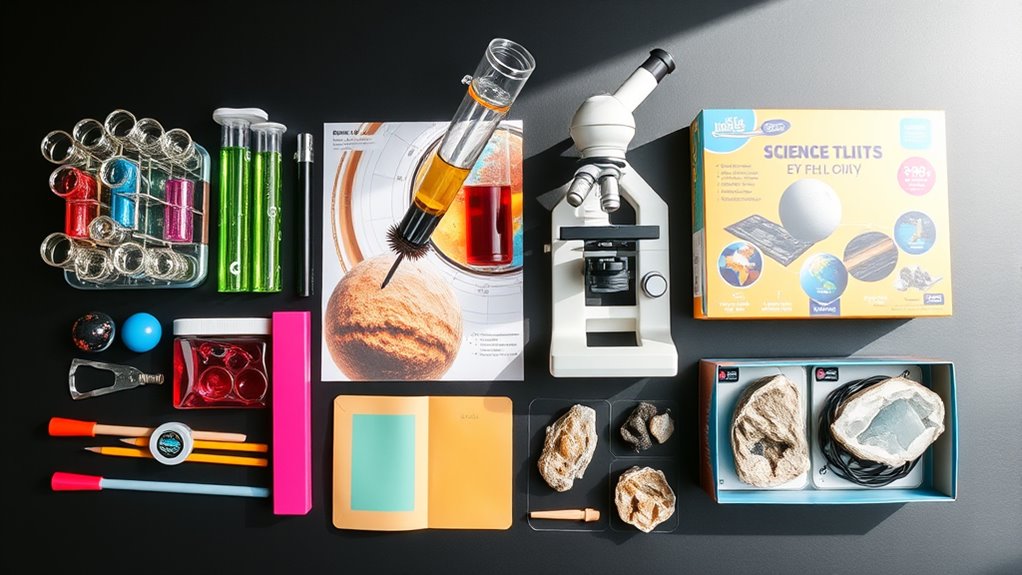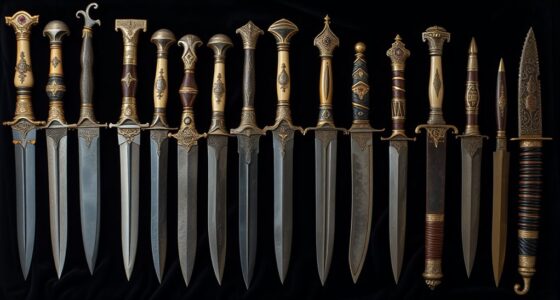If you’re looking for the best science kits to inspire curiosity in teenagers, I’ve found some fantastic options that cover everything from chemistry and robotics to earth science and magic. These kits are designed with age-appropriate complexity, hands-on experiments, and educational depth, ensuring a fun and engaging experience. Whether they want to build hydraulic hands or explore chemical reactions, there’s something for every curious teen. Keep exploring, and you’ll discover even more exciting choices.
Key Takeaways
- Offer a variety of STEM topics like robotics, chemistry, physics, and environmental science tailored for teenagers aged 8-16.
- Include comprehensive, safe kits with detailed instructions, experiments, and materials to foster hands-on learning and curiosity.
- Feature engaging options such as robotics, magic, and gross science to stimulate interest and critical thinking.
- Ensure safety with high-quality materials, safety gear, and clear supervision guidelines suitable for teen exploration.
- Provide educational depth with advanced experiments, real specimens, and resources to deepen understanding and inspire further discovery.
National Geographic Mega Science Lab Kit for Kids

Are you looking for an all-inclusive science kit that can keep teenagers engaged and curious? The National Geographic Mega Science Lab Kit for Kids is perfect for sparking their interest. It offers over 130 experiments across earth science, chemistry, and science magic, plus a bonus guide with 85+ household experiments. Kids can build volcanoes, grow crystals, or dig up fossils, all while learning important scientific concepts. The kit includes real rock, mineral, and crystal specimens, making it both fun and educational. With detailed instructions and safety gear, it encourages responsible exploration. It’s a highly-rated, award-winning set that transforms learning into an exciting adventure.
Best For: children and teenagers aged 8 and up who are curious about science and enjoy hands-on, educational experiments.
Pros:
- Offers over 130 engaging experiments in earth science, chemistry, and magic to foster curiosity and learning.
- Includes real rock, mineral, and crystal specimens for a tactile, educational experience.
- Comes with detailed instructions and safety gear, making it suitable for independent or supervised exploration.
Cons:
- The kit can be messy, requiring cleanup after experiments.
- Some experiments may require adult supervision, especially for younger children.
- The size and weight (5.81 pounds) may make it less convenient for travel or storage in small spaces.
Playz Mega Kaboom! Science Experiments Kit for Kids

The Playz Mega Kaboom! Science Experiments Kit for Kids offers over 150 explosive experiments designed for children aged 8-12. I love how it combines fun with learning, featuring activities like balloon rockets, fizzy bombs, and color explosions that spark curiosity. The kit includes a detailed lab guide, plus 75 app and video-guided experiments, making science interactive and accessible. It’s compact and safe, encouraging kids to explore chemistry and physics through hands-on activities. While some may find the chemical supplies limited, the engaging experiments and educational value make it a fantastic gift for young science enthusiasts enthusiastic to discover the wonders of science.
Best For: children aged 8-12 who are interested in fun, hands-on science experiments that combine education with entertainment.
Pros:
- Offers over 150 engaging experiments including balloon rockets, fizzy bombs, and color explosions.
- Includes a detailed lab guide along with 75 app and video-guided activities to enhance interactivity.
- Compact size and safe design make it suitable for home use and gift-giving.
Cons:
- The chemical supplies and tools may be limited, requiring additional purchases for more advanced experiments.
- Some users find the experiments somewhat basic and the scope may not fully match the “Mega” label.
- Instructions can occasionally be inaccurate or repetitive, which may affect the learning experience.
National Geographic Chemistry Set for Kids (Ages 8-12)
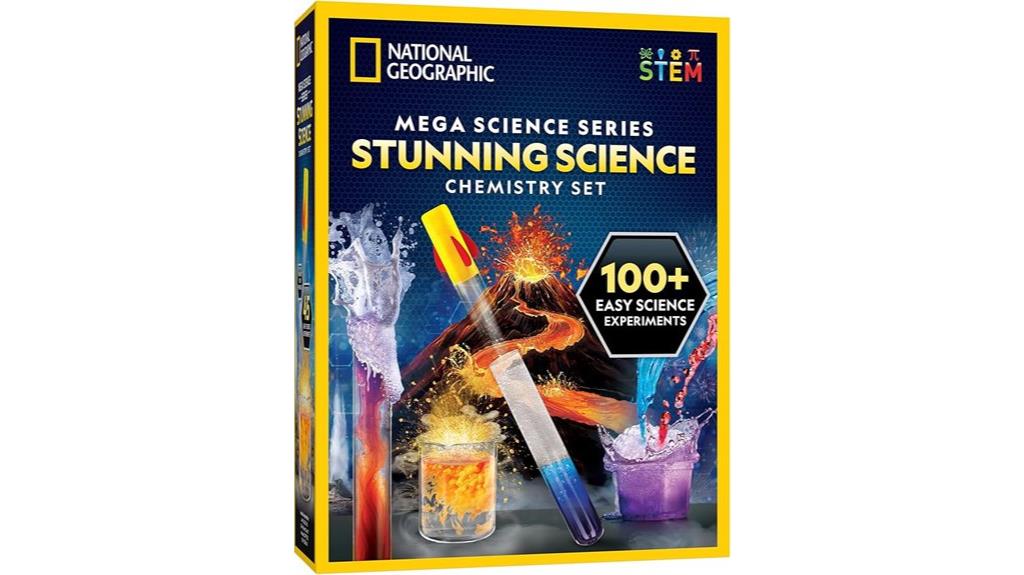
Looking for a science kit that sparks curiosity and provides hands-on learning for kids aged 8-12? The National Geographic Chemistry Set is perfect. It features 45 experiments like building volcanoes, creating geysers, and launching rockets, making chemistry fun and engaging. The kit includes all necessary materials and easy-to-follow instructions with illustrations, promoting STEM skills and safety. Compact and portable, it’s suitable for individual or group activities. With high-quality components and positive reviews, it’s a reliable choice for inspiring young scientists. It’s an excellent gift that combines education and entertainment, fostering a lifelong interest in science.
Best For: provides engaging and educational chemistry experiments for children aged 8-12 who are curious about science and enjoy hands-on learning experiences.
Pros:
- Contains 45 fun and easy-to-conduct experiments that promote STEM learning
- Includes all necessary materials with clear, illustrated instructions
- High customer ratings (4.7/5 stars) reflect quality, durability, and educational value
Cons:
- Instructions are only available in English, which may challenge non-English speakers
- The kit’s size (8.78 x 3.19 x 11.93 inches) may limit portability for some users
- Requires supervision for safe experimentation, which might be a consideration for some parents or teachers
National Geographic Gross Science Kit for Kids (Amazon Exclusive)
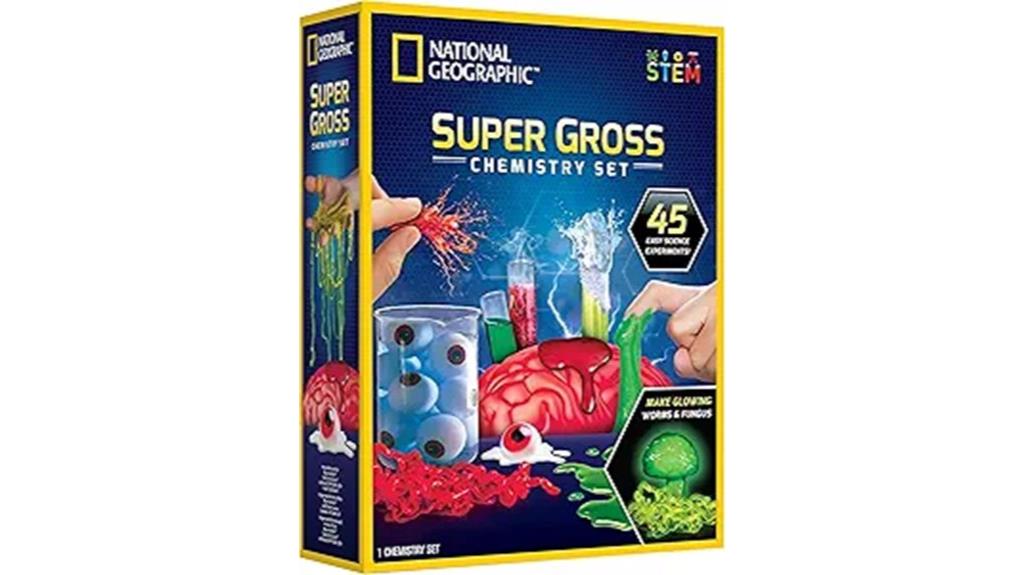
For teens curious about the bizarre side of science, the National Geographic Gross Science Kit for Kids offers an engaging way to explore creepy and gross experiments that spark curiosity. With 45 experiments, including dissecting a brain, making slime, and creating glowing worms, it combines fun with learning. The kit provides all necessary materials for 15 experiments and suggests household items for more. Kids can explore polymers, chemical reactions, and pH science while developing practical skills. Praised for quality, clear instructions, and organization, this kit keeps children entertained for hours. It’s perfect for curious teens who love strange science and hands-on discovery.
Best For: curious children and teens aged 8 and up who love gross, strange, and hands-on science experiments that make learning fun and engaging.
Pros:
- Offers 45 gross science experiments that are both educational and entertaining
- High-quality materials with clear, kid-friendly instructions and illustrations
- Encourages STEM learning by exploring polymers, chemical reactions, and pH science
Cons:
- Experiments can be messy, requiring preparation of workspace and cleanup
- Some household items needed for additional experiments may not be included in the kit
- The size and weight (approximately 11.81 x 8.66 x 3.15 inches, 2.14 pounds) may require dedicated storage space
Thames & Kosmos Mega Cyborg Hand STEM Kit

If you’re a teen enthusiastic to explore robotics and engineering hands-on, the Thames & Kosmos Mega Cyborg Hand STEM Kit stands out as an excellent choice. With over 200 plastic pieces and piston tubes filled with water, you can build a hydraulic, wearable hand that mimics human movements—no motors or batteries needed. It’s capable of gripping objects like bottles and pencils, and adjustable for different hand sizes and styles. The detailed 40-page manual explains pneumatic and hydraulic systems used in industrial robots. This kit offers a practical introduction to engineering, hydraulics, and robotics, making complex concepts accessible while fostering patience, focus, and problem-solving skills.
Best For: Teenagers and older children interested in exploring robotics, engineering, and hands-on STEM projects.
Pros:
- Provides a realistic, functional hydraulic hand that mimics human movements without motors or batteries
- Includes a comprehensive 40-page manual explaining pneumatic and hydraulic systems used in industry
- Promotes skills such as focus, patience, problem-solving, and fine motor dexterity
Cons:
- Assembly can be time-consuming and may require adult supervision, especially for younger users
- Some parts may be flimsy or require careful handling, lubrication, and precise fitting
- Larger size and certain components may be uncomfortable for extended wear or smaller hands
4M Clean Water Science Lab for Kids & Teens
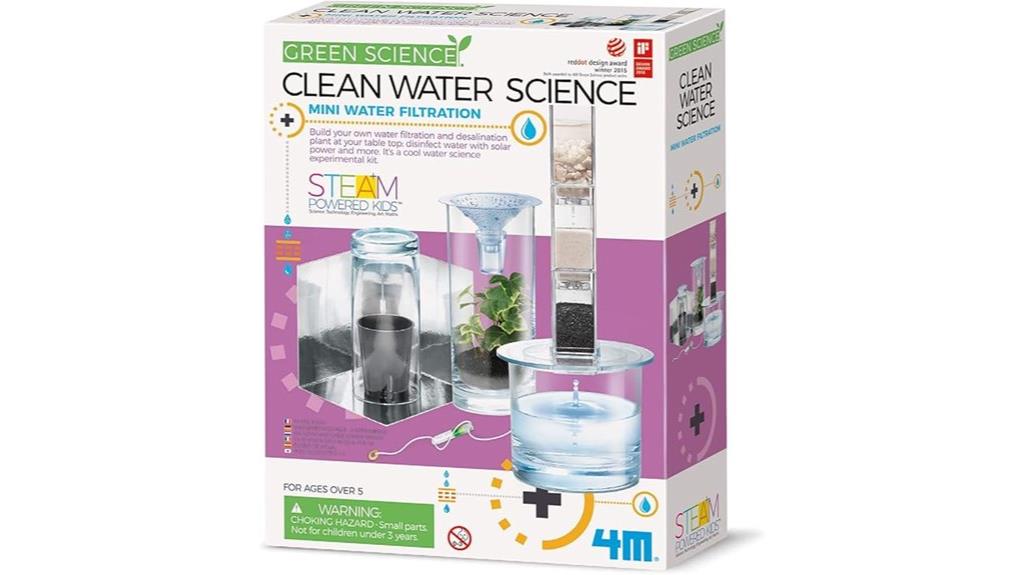
The M Clean Water Science Lab for Kids & Teens is an excellent choice for young science enthusiasts enthusiastic to explore water purification and environmental science firsthand. This kit includes a plastic filter system, active carbon, sand, rocks, filter paper, a funnel-shaped collector, and detailed instructions, making assembly straightforward. It allows users to build a water filtration and desalination plant, disinfect water using solar power, and conduct experiments on cleaning and reusing dirty water. Designed for ages 8 and up, it promotes environmental awareness, scientific inquiry, and problem-solving skills, making it perfect for school projects, science fairs, or STEM learning at home.
Best For: young science enthusiasts aged 8 and up interested in exploring water purification, desalination, and environmental science through hands-on STEM activities.
Pros:
- Includes comprehensive materials like filter system, active carbon, sand, and detailed instructions for easy assembly.
- Promotes environmental awareness and scientific inquiry with practical experiments on water cleaning and reuse.
- Suitable for educational purposes such as school projects, science fairs, and STEM learning at home.
Cons:
- Some users report tight tolerances on adapters and minor wiring troubleshooting during assembly.
- Small size of filtering materials limits the volume of water that can be processed in each experiment.
- The product may be less engaging for children under 8 or those who prefer larger or more complex science kits.
NATIONAL GEOGRAPHIC Science Magic Kit for Kids
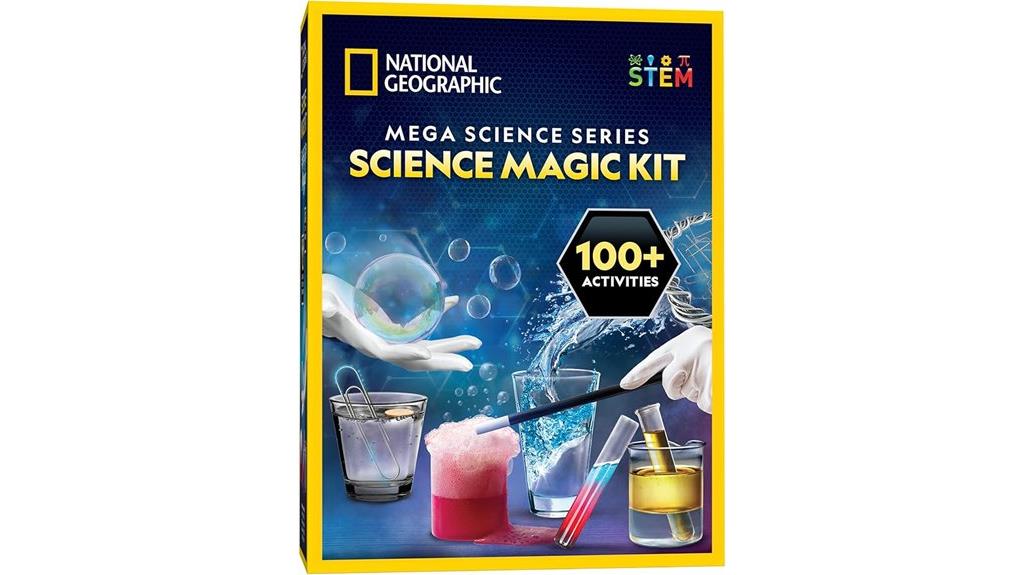
The NATIONAL GEOGRAPHIC Science Magic Kit for Kids stands out as an excellent choice for children aged 8 and up who are curious about science and enjoy hands-on activities. It offers over 100 experiments and magic tricks that blend physics and chemistry, such as making coins float or bending metal with water. The kit includes all necessary materials, like a magic wand and gloves, making setup easy and engaging. Recognized with the Toy of the Year Award, it emphasizes education, creativity, and fun. Perfect for sparking curiosity and STEM interests, this kit keeps kids entertained while fostering critical thinking and scientific inquiry.
Best For: children aged 8 and up who are interested in exploring science through fun, hands-on experiments and magic tricks to foster curiosity and STEM skills.
Pros:
- Offers over 100 engaging experiments and 20 magic tricks that combine physics and chemistry for a comprehensive learning experience
- Includes all necessary materials and clear instructions, making it easy and safe for kids to perform experiments independently or with family
- Recognized with the Toy of the Year Award, highlighting its educational value, creativity, and high-quality design
Cons:
- Some powders and materials may need to be discarded after opening, requiring resealable packaging for convenience
- Designed for children 8 and older, so younger kids may need adult supervision or assistance
- Limited to Amazon purchasing, which might not suit customers preferring in-store options
UNGILINGA 150 Experiments Science Kits for Kids

UNGILINGA 150 Experiments Science Kits for Kids stands out as an excellent choice for curious teenagers enthusiastic to explore science hands-on. With 150 experiments spanning earth science, chemistry, physics, and surface tension, it offers endless opportunities for discovery. The well-illustrated manual makes each project easy to follow, encouraging independent learning and parent-child collaboration. All high-quality tools and kid-safe materials are included, ensuring safe and realistic experiments. Perfect as a gift for birthdays or holidays, this kit nurtures curiosity, enhances understanding of complex topics, and makes science engaging and fun, fostering a lifelong love for discovery.
Best For: curious teenagers and young science enthusiasts eager to explore a wide range of scientific concepts through hands-on experiments.
Pros:
- Includes 150 diverse experiments covering multiple science disciplines for extensive exploration.
- Comes with a detailed, well-illustrated manual that simplifies complex scientific procedures.
- All necessary high-quality tools and safe materials are provided, ensuring safe and realistic experiments.
Cons:
- The large number of experiments may be overwhelming for some beginners to complete all at once.
- The kit’s detailed manual might be too advanced for very young children without adult assistance.
- The extensive variety of experiments could require significant time commitment to fully enjoy and learn from.
STEM Bluetooth Speaker DIY Kit for Kids & Adults
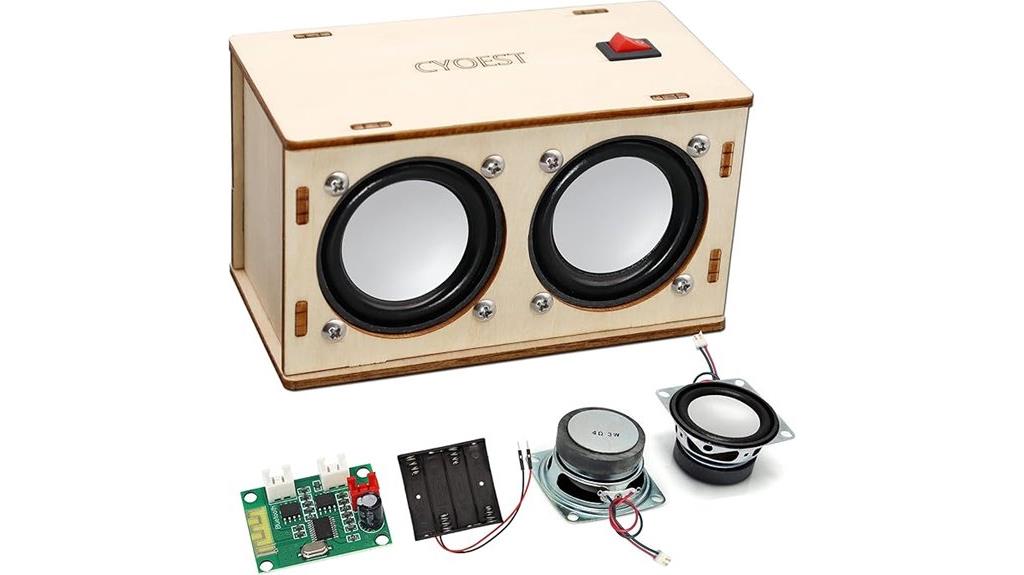
If you’re looking for a hands-on STEM project that’s perfect for beginners and hobbyists, the DIY Bluetooth speaker kit stands out as an excellent choice for kids and adults alike. Made with a wooden shell, Bluetooth board, and electronic components, it offers a simple assembly process that takes about 30 minutes, with no soldering required. The kit provides a clear learning experience about electronics, circuitry, and sound technology, encouraging problem-solving and creativity. Compact and stylish, it’s a fun project that results in a functional Bluetooth speaker, making it a unique gift for birthdays, holidays, or family activities. It’s suitable for ages 10 and up.
Best For: beginners, kids, and hobbyists looking for an easy, educational STEM project to build a functional Bluetooth speaker.
Pros:
- No soldering or welding required, making it accessible for beginners and young users
- Provides hands-on learning about electronics, circuitry, and sound technology
- Compact, stylish design makes it an engaging gift for various occasions
Cons:
- Batteries (4 AA) are not included, requiring additional purchase
- Sound quality is modest compared to high-end speakers
- Assembly takes around 30 minutes, which may still be challenging for very young children without supervision
4M Crystal Growing Science Kit with Display Cases

For teenagers interested in hands-on science experiments, the 4M Crystal Growing Science Kit with Display Cases offers an engaging way to explore chemistry and geology. It includes all the materials needed for seven crystal growth experiments, such as crystal compounds, display domes, stirring sticks, and clear instructions. You dissolve the crystal mixture in hot water, then wait several days for beautiful crystals to form—some reaching up to two inches. Watching crystals grow overnight creates a sense of discovery and patience. The kit’s colorful crystals and display cases make for a striking presentation, inspiring curiosity and providing a tangible way to learn about natural science processes.
Best For: curious teenagers and young science enthusiasts interested in hands-on chemistry and geology experiments.
Pros:
- Comprehensive kit with all necessary materials for multiple crystal experiments.
- Educational and engaging, promoting patience, observation, and scientific understanding.
- Attractive display cases and colorful crystals enhance visual appeal and motivation.
Cons:
- Crystal sizes may be smaller or less impressive than expected for some users.
- Crystal formation can be delayed or inconsistent, requiring patience and careful handling.
- Fragile crystals and geodes can be brittle, and some users may find the results less satisfying.
ELEGOO UNO R3 Robot Car Kit V4 for Arduino STEM Robotics for Kids
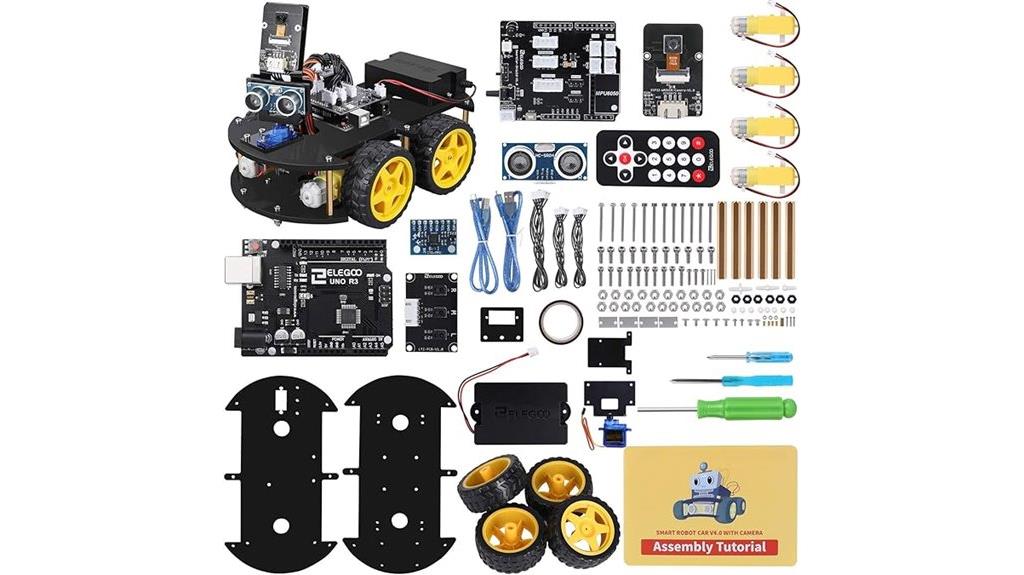
The ELEGOO UNO R3 Robot Car Kit V4 stands out as an excellent choice for young learners enthusiastic to explore robotics and programming, especially those aged 8 to 16. I love how it offers hands-on experience in electronics assembly and coding, making STEM concepts accessible and engaging. With 24 modules, including obstacle avoidance, line tracing, and remote control, it supports diverse projects and remote operation via phone or tablet. The modified ports simplify assembly, reducing errors for beginners. Plus, HD tutorials guide users step-by-step, ensuring a smooth learning process. Overall, this kit combines fun and education, nurturing engineering skills in a user-friendly way.
Best For: young learners aged 8-16 interested in exploring robotics, programming, and STEM concepts through hands-on building and coding experiences.
Pros:
- Comprehensive kit with 24 modules supporting diverse robotics projects and remote control options.
- Simplified assembly with modified ports, reducing errors and making setup beginner-friendly.
- Includes detailed HD tutorials and all necessary programming codes to facilitate effective learning.
Cons:
- Basic electronic knowledge recommended, which may require additional guidance for complete beginners.
- May need supervision or assistance for younger children during assembly and programming.
- Limited advanced features, potentially requiring upgrades for more complex robotics projects.
Teach Tech Hydrobot Arm Kit, Hydraulic STEM Building Toy for Kids 12

Building mechanical engineering skills becomes engaging and hands-on with the Teach Tech Hydrobot Arm Kit, a hydraulic STEM building toy designed specifically for teenagers aged 12 and up. This kit guides you through constructing a real, functioning robot powered by water hydraulics, with no batteries needed. It features six axes that rotate 270 degrees and allows for customization with grippers or suction cups to manipulate objects. Using levers and fluid power, it demonstrates key engineering principles while boosting problem-solving and critical thinking. I find it a fantastic way to combine science, technology, and creativity, making learning both fun and educational.
Best For: Teenagers aged 12 and up interested in hands-on STEM learning, engineering, and robotics projects.
Pros:
- Engages students with practical, hands-on building experience in mechanical engineering.
- Demonstrates hydraulic power and fluid mechanics without the need for batteries.
- Promotes critical thinking, problem-solving, and creativity through customizable features.
Cons:
- May require adult supervision for younger users or beginners.
- Limited to water hydraulics, which might not cover all aspects of electronics or motorized robotics.
- The complexity of assembly could be challenging for some users without prior building experience.
4M Kidzlabs Anti Gravity Magnetic Levitation Science Kit

Looking for an engaging science kit that sparks curiosity about magnetism and physics? The 4M Kidzlabs Anti Gravity Magnetic Levitation Science Kit is perfect for that. It teaches kids about magnetic forces through fun experiments like floating a pencil, levitating screws, and building a maglev. Designed for ages 8 and up, it includes all the necessary materials and clear instructions, making learning both easy and enjoyable. Kids can explore the invisible powers of magnetism, fostering a deeper understanding of physics. With durable components and a hands-on approach, this kit keeps young minds curious and excited about science for hours.
Best For: children aged 8 and up who are interested in exploring magnetism, physics, and STEM concepts through hands-on experiments.
Pros:
- Engages kids with fun, interactive experiments that demonstrate magnetic levitation and forces
- Includes all necessary materials with clear, detailed instructions for easy assembly and learning
- Promotes curiosity and understanding of scientific principles, making it an excellent educational STEM toy
Cons:
- Some parts may fit loosely or be fragile if not handled carefully
- Small print on instructions can be difficult to read for young children
- The magnets’ strength and plastic quality may not meet all users’ expectations, and some find the price relatively high
Thames & Kosmos Chemistry Chem C500 Science Kit
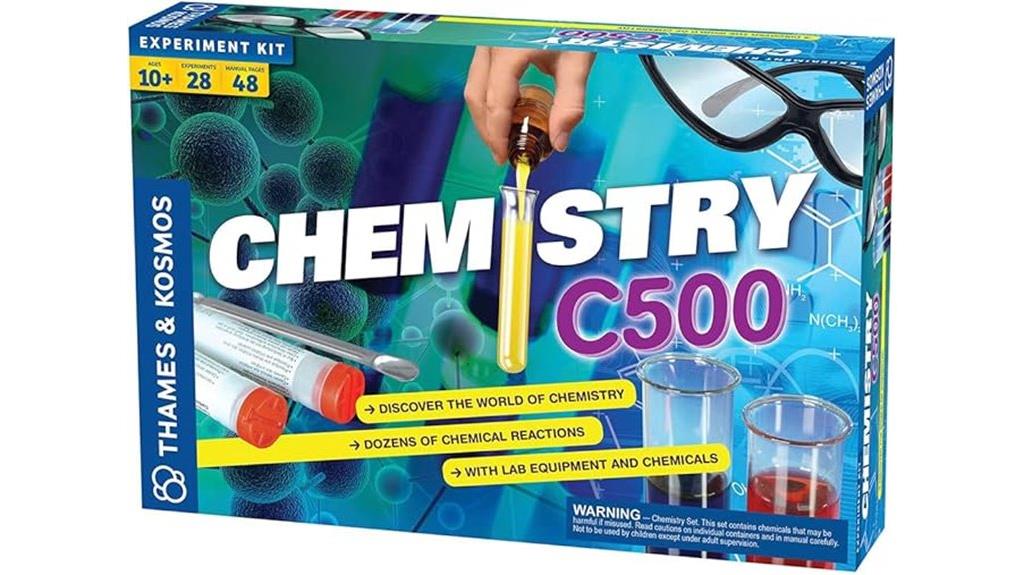
If you’re searching for an engaging chemistry kit suitable for beginners, Thames & Kosmos Chemistry Chem C500 Science Kit stands out as an excellent choice for teenagers aged 10 to 15. It features 28 classic experiments, a detailed 48-page manual with simple instructions, and real chemicals, glassware, and safety gear. The kit introduces fundamental concepts like chemical reactions, acids, bases, and states of matter through hands-on activities. Recognized with a Parents’ Choice Silver Award, it fosters curiosity and critical thinking. While some supplies are limited, it offers a safe, educational introduction to chemistry, making science both fun and accessible for young learners.
Best For: beginners and young teenagers aged 10 to 15 who want a safe, engaging, and educational introduction to chemistry concepts.
Pros:
- Includes real chemicals, glassware, and safety gear for hands-on learning.
- Offers 28 classic experiments with a comprehensive, easy-to-follow manual.
- Recognized with a Parents’ Choice Silver Award, ensuring quality and educational value.
Cons:
- Limited supply of chemicals may restrict the number of experiments or duration of use.
- Manual may arrive damaged; access online, but a physical copy would be preferable.
- Requires adult supervision and additional household supplies like vinegar and paper for full experimentation.
National Geographic Magic Chemistry Set for Kids

The National Geographic Magic Chemistry Set for Kids is an excellent choice for young science enthusiasts aged 8-12 who love combining education with fun. This kit includes 10 magic tricks that demonstrate scientific principles like floating coins, color-changing water, and creating snow. It comes with all the tools needed, including a magic wand and white gloves, so kids can start experimenting right away. The high-quality materials and clear instructions make it safe and easy for kids to explore science independently. Recognized with awards like Toy of the Year, it’s perfect for sparking curiosity, creativity, and critical thinking through hands-on learning and entertaining magic tricks.
Best For: young children aged 8-12 who are curious about science and enjoy performing magic tricks that demonstrate scientific principles.
Pros:
- Engages kids with fun, hands-on science experiments that promote learning and creativity.
- Includes all necessary tools and clear instructions, making it easy and safe for children to use independently.
- Recognized with awards like Toy of the Year, highlighting its quality, educational value, and entertainment factor.
Cons:
- Lacks eye protection gear, which could enhance safety during experiments.
- Limited variety in magic tricks might reduce long-term interest for some users.
- Some users find the messiness of certain experiments a bit challenging to manage.
Factors to Consider When Choosing Science Kits for Teenagers
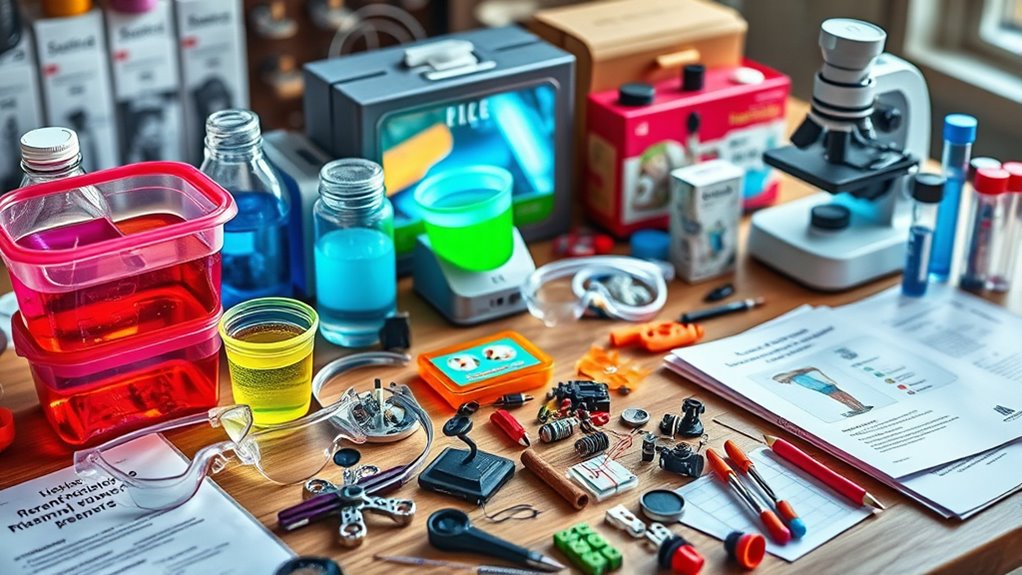
When selecting a science kit for a teenager, I focus on whether it’s suitable for their age and skill level to keep them engaged without frustration. Safety measures are a top priority to guarantee a fun learning experience, while the educational depth should challenge them appropriately. Additionally, I check that the materials are of good quality to ensure durability and safety during experiments.
Age Appropriateness
Choosing the right science kit for a teenager means paying close attention to their age and developmental stage. It’s vital to select kits labeled for ages 12 and up, ensuring they meet safety and maturity standards. Check if the experiments are suited for their skill level—challenging enough to stimulate growth but not so complex they become frustrating. Look for clear instructions and safety guidelines that match their ability to follow procedures independently. Consider the materials and chemicals included—are they safe and appropriate for their maturity? Finally, verify the content aligns with their educational level and interests, providing enough depth to keep them engaged while fostering a genuine love for science. These factors help make the experience both safe and enriching.
Skill Level Match
How can you guarantee that a science kit matches a teenager’s skill level? First, check the age recommendations on the packaging; they often reflect complexity and safety considerations. Next, consider the number and difficulty of experiments included—aim for a balance that challenges without overwhelming. Review the required prior knowledge, like basic chemistry or programming skills, to ensure the teen can comfortably follow along. It’s also helpful to choose kits that offer progressive learning, allowing skills to build over time with more advanced experiments. By matching the kit’s complexity with the teen’s current knowledge and experience, you help prevent frustration and boredom while fostering genuine curiosity. Selecting a kit aligned with their skill level makes the learning experience enjoyable and rewarding.
Safety Measures
Ensuring safety is a critical aspect of selecting the right science kit for teenagers. I always check that the kit includes essential safety gear like goggles, gloves, and lab aprons to protect young experimenters. It’s also essential that all chemicals and materials are non-toxic, food-grade, and meet safety standards such as ASTM or CE certifications, guaranteeing they’re safe for use. Clear safety instructions and warnings should accompany the kit, especially for handling hot, sharp, or reactive substances, so accidents are minimized. I also look for designs that reduce mess and spillage, with secure containers and proper storage options for hazardous materials. Finally, age-appropriate labeling and supervision guidelines help ensure the kit is suitable and safe for the teenager’s maturity level.
Educational Depth
The educational depth of a science kit plays a crucial role in fostering meaningful learning experiences for teenagers. It reflects the complexity and accuracy of experiments, which should match their current knowledge and curiosity. Kits exploring advanced topics like organic chemistry, robotics, or environmental science offer deeper insights than basic sets, encouraging critical thinking. Including detailed manuals, explanations of scientific principles, and supplementary resources enhances the learning process. A well-designed kit challenges teens with open-ended experiments that promote problem-solving, hypothesis testing, and scientific inquiry. However, it’s vital to balance complexity with safety, ensuring they can perform experiments independently while gaining valuable scientific understanding. Ultimately, the right educational depth keeps teens engaged and nurtures their curiosity without overwhelming them.
Material Quality
Choosing a science kit for teenagers hinges profoundly on the quality of its materials since durable, safe components make experiments both enjoyable and reliable. High-quality materials guarantee the kit withstands frequent use and provides accurate results, which enhances the learning experience. Premium glassware and electronic parts are not only more durable but also improve precision during experiments. It’s essential that plastics and chemicals are non-toxic and child-safe, allowing teenagers to explore science confidently without health concerns. Well-made kits include sturdy tools and accessories that last over time, offering better value. Overall, the material quality reflects a manufacturer’s dedication to safety standards and educational effectiveness, giving both parents and teens peace of mind while fostering curiosity and skill development.
Experiment Variety
Have you ever considered how the variety of experiments in a science kit can impact a teen’s learning experience? A diverse selection keeps their interest alive by offering multiple avenues to explore chemistry, physics, biology, and earth sciences. When a kit includes different types of experiments, teens develop a broader understanding of scientific principles through hands-on activities. This variety also maximizes value, as multiple experiments often share tools or chemicals, allowing for repeated use. Exposure to different scientific disciplines can spark curiosity and inspire teens to pursue specific interests or careers. Plus, a well-rounded kit with varied experiments prevents boredom and encourages ongoing learning, as new challenges and discoveries keep the experience fresh and engaging over time.
Budget Considerations
A variety of experiments makes a science kit engaging and educational, but it’s important to also consider how much it costs. Science kits for teenagers range from around $20 for basic sets to over $100 for more advanced options. Setting a clear budget helps narrow choices and ensures you get good value without overspending. Keep in mind that some kits require additional purchases like chemicals, tools, or accessories to complete experiments or expand their use. Look for a balance between affordability and quality, making sure the kit is safe, durable, and educational. Prioritizing your budget helps you focus on features like experiment complexity, the number of activities, and included materials, so you find the best fit for your teen’s interests and your financial comfort.
Frequently Asked Questions
What Safety Precautions Should Teens Follow During Experiments?
Teens should always wear safety goggles and gloves to protect their eyes and skin during experiments. I recommend reading all instructions carefully before starting and working in a well-ventilated area. Never mix chemicals without knowing the proper procedures, and keep a fire extinguisher nearby. Always ask for adult supervision if you’re unsure about any step. Safety first, so you can enjoy exploring science without unnecessary risks.
Are These Kits Suitable for Homeschooling or Classroom Use?
Absolutely, these kits are perfect for homeschooling or classroom use! I’ve seen firsthand how they transform a simple science lesson into an exciting adventure, making students’ eyes light up with wonder. They’re easy to set up, packed with all the essentials, and designed to be safe and educational. Whether in a cozy home classroom or a bustling school lab, these kits turn curious teens into mini scientists in no time!
How Do Science Kits Support Long-Term STEM Skill Development?
Science kits support long-term STEM skill development by engaging teens in hands-on experiments that foster critical thinking, problem-solving, and creativity. I’ve seen how these kits build a strong foundation in scientific concepts and inspire curiosity to explore further. When teens repeatedly practice these skills through fun, practical activities, they develop confidence and a genuine interest in STEM, setting them up for future success in science, technology, engineering, and math.
Can These Kits Be Used to Prepare for Science Competitions?
Absolutely, these kits can be a great way to prepare for science competitions. I’ve used them to deepen my understanding of key concepts, practice hands-on experiments, and build confidence in my skills. They help me explore topics more thoroughly and develop problem-solving abilities. Plus, they’re fun and engaging, making learning feel less like a chore. If you’re serious about competing, these kits are a solid study tool.
What Age Range Is Optimal for the Most Benefit From These Kits?
I believe the ideal age range for these science kits is between 12 and 16 years old. At this stage, teens have enough curiosity and foundational knowledge to fully engage with complex experiments, while still being excited by hands-on activities. I’ve seen younger kids enjoy simpler projects, but for the most benefit and meaningful learning, I recommend kits tailored to middle and early high school students.
Conclusion
Choosing the right science kit can ignite a teenager’s passion for discovery. Imagine a shy teen building their first robot or mixing a colorful chemical reaction that sparks a newfound confidence. I’ve seen firsthand how a well-chosen kit transforms curiosity into lifelong learning. So, pick one that excites them—it’s more than just a toy; it’s the start of their scientific journey. Let their curiosity lead the way!
